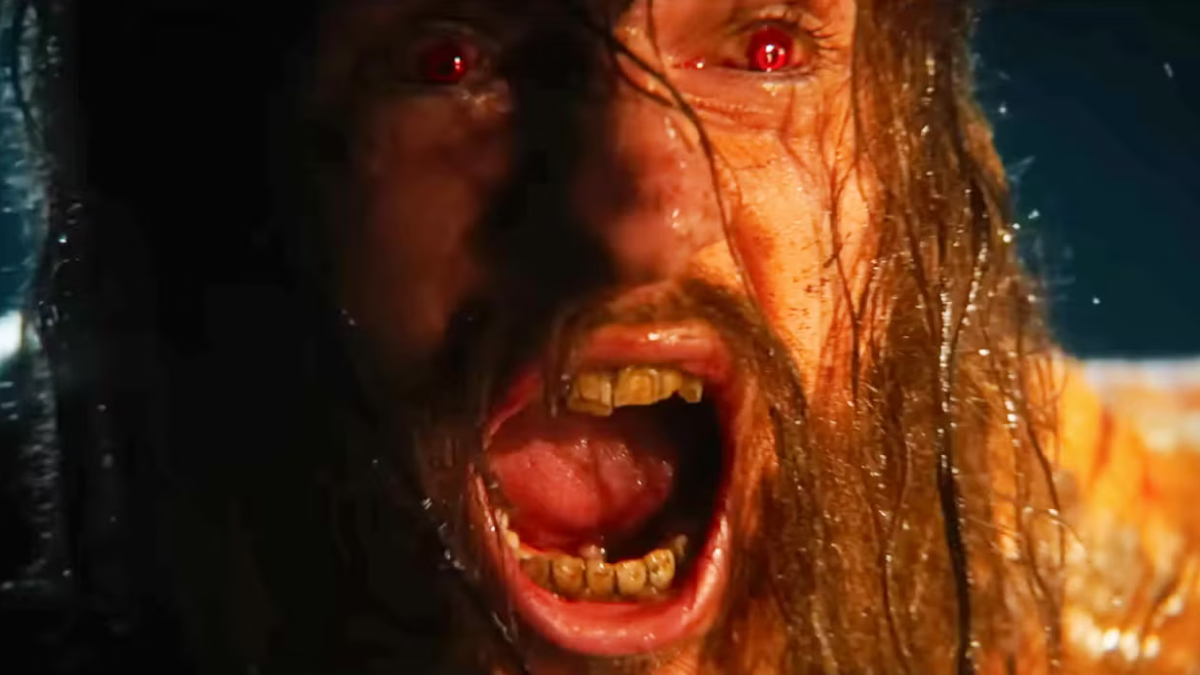Alpha Zombie Scene 28 has stirred massive buzz; The horror genre has never shied away from controversy, but rarely does a single frame grip the internet the way Scene 28 from 28 Years Later has. On social media, what should have been another tense, blood-soaked moment in a post-apocalyptic world has instead sparked debates, think pieces, and memes not because of gore or violence, but because of one particular, stunning image. What could have been a minor detail has become the main topic of conversation about the movie all over the world thanks to the prosthetic appendage that is seen swinging freely on screen.
Not only is the shock of nudity what makes this moment so remarkable, but the very conscious decision that led to it as well. Indeed, it was intentional.
The Scene That Stopped Audiences Cold
The Alpha Zombie Samson, portrayed by professional MMA fighter Chi Lewis-Parry, is first shown to viewers in the now-viral Alpha zombie Scene 28. Strong and towering, he screams onto the scene naked, covered in blood, and brimming with animalistic fury. As he charges through a dark hallway, the camera closely tracks his movements raw, primal, terrifying.
But one particular element distracts from the terror. It’s obvious, conspicuous, and not computer-generated imagery. At that point, viewers started to pause, grab screens, and share their astonished reactions. Questions spread quickly. Was this a joke? A mistake? An accident overlooked in editing?
It wasn’t, It was a prosthetic and it was absolutely intentional.
A Legal Requirement Becomes a Viral Storm
What many viewers didn’t realize is that the prosthetic was used out of legal necessity. A child actor playing a newborn baby was one of the minors on set. Even in a professional film setting, full-frontal nudity is forbidden during scenes involving minors due to stringent UK regulations.
The production team decided to use a prosthetic in order to comply with the law, guaranteeing everyone’s comfort and safety. Later, director Danny Boyle clarified that although the prosthetic was initially useful, it soon acquired greater meaning.Boyle, known for challenging visual norms and pushing cinematic boundaries, saw an opportunity to enhance the character of Samson through this explicit but purposeful choice. The result? A moment that blurred the line between story and spectacle.

Symbolism Behind the Shock
It would be easy to dismiss the prosthetic as a tasteless joke or a gimmick designed for shock value. But that interpretation sells the moment short. Samson is not a mindless drone. He represents something different—an evolution of the infected. He moves with purpose. His eyes register pain and awareness. And, in a haunting twist, he shows empathy. If you’re looking for real-time visuals of alpha zombie scene 28, visit here and look through the bizarre on screen moments of it.
In the same scene, a human baby—delivered by an infected mother—cries out. This baby is not infected. Somehow, it has survived the birthing process unscathed, signaling a potential mutation in the virus. The camera lingers on Samson’s reaction. He does not attack. Instead, he stares, confused, even protective. When the child is threatened, Samson reacts with fury, suggesting emotional depth rarely seen in creatures of this genre.
In that moment, the prosthetic becomes more than a legal workaround or a viral oddity. It signals a radical shift in how we interpret zombies. This is not a decaying husk driven by hunger. This is a creature becoming something new—something terrifyingly human.
Redefining the Zombie Mythos
The traditional zombie has always followed a set of unwritten rules. They are slow or fast, but always mindless. They do not think. They do not love. And they certainly do not reproduce. But 28 Years Later throws these tropes into the fire and watches them burn.
By introducing the idea that the infected can give birth, and that those offspring may survive without infection, the film suggests a terrifying possibility: evolution. Zombies no longer represent the end of humanity; they may become its next chapter. And Samson, as the Alpha, stands at the forefront of that change.
His nudity, once viewed as grotesque or humorous, now becomes part of the narrative. It strips away the last vestiges of modesty or shame. He is nature unleashed, no longer bound by civilization’s expectations or rules. The prosthetic, therefore, is not about shock. It’s about the truth.
The Internet Can’t Stop Watching
When the film premiered, Alpha Zombie Scene 28 began trending almost immediately. Memes surfaced by the minute. The phrase “28 Inches Later” began circulating online, turning a horror movie moment into a full-blown internet phenomenon. Clips were posted with shocked reactions. Edits slowed down the footage for comedic effect. Fan theories piled up on Reddit, some thoughtful, others wildly speculative.
Everyone had an opinion. Some viewers were uncomfortable. Others couldn’t stop laughing. A few accused the film of going too far. But no one could deny the impact. Alpha Zombie Scene 28 became the most discussed moment of the entire movie—and perhaps the entire zombie genre.
In interviews, Danny Boyle admitted he expected the scene to get attention. However, even he appeared taken aback by how much it overshadowed the remainder of the movie’s plot. Nevertheless, he defended the choice, highlighting the scene’s symbolic significance and the prosthetic’s function in representing a creature free from human conventions.

A Cultural Turning Point in Horror
There’s a reason this moment matters beyond its viral fame. Alpha Zombie Scene 28 forces viewers to ask new questions about what it means to be “infected.” It challenges us to think differently about the creatures we’ve been taught to fear. In doing so, it breathes new life into a genre that often recycles the same tropes.
Samson is not just a frightening monster. He’s a signpost pointing toward the future of horror, one where infection doesn’t just destroy humanity, but reshapes it.
The prosthetic may have been the punchline, but the punch it delivers is real. The scene reveals how cinema can weaponize surprise, how it can use shock not for cheap laughs but to make a point. Horror at its best has always reflected deeper truths about society. And in Alpha Zombie Scene 28, buried beneath the chaos and disbelief, is a statement about evolution, control, and the primal forces we pretend don’t exist.
Conclusion
Alpha Zombie Scene 28 will be remembered for many reasons. Some will laugh at the prosthetic. Some will criticize its visibility. But others will look closer and see something more profound—a turning point for horror. A bold choice that redefines the zombie archetype and sparks real discussion.
The Alpha Zombie wasn’t just part of a fight scene. He became the film’s biggest mystery, its wildest moment, and its most talked-about symbol. Whether intentional or not, the prosthetic turned a standard action sequence into a pop culture phenomenon.
And if you’re still wondering whether it was all a stunt?
It was. And it wasn’t.
That’s what makes it brilliant.





